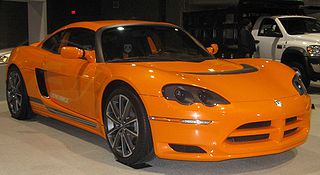Think Global was a Norwegian electric car manufacturer located in Bærum, which manufactured cars under the TH!NK brand. Production of the Think City was stopped in March 2011 and the company filed for bankruptcy on June 22, 2011, for the fourth time in 20 years. The company was bought soon after by Electric Mobility Solutions AS and production ceased in August 2012 with no more announcements regarding future production. As of October 2010, a total of 2,500 units had been manufactured at Oslo-based TH!NK's production facility.

AC Propulsion is a San Dimas, California, USA company founded in 1992 by Alan Cocconi, Wally Rippel, and Paul Carosa, that specializes in alternating current-based drivetrain systems for electric vehicles. It offers AC-induction traction motors. The company produces electric vehicle drive systems featuring high performance, high efficiency induction motors and integrated high power battery charging. Previously, they built an electric sports car, the tzero and the eBox, an electric conversion based on the Scion XB. They also develop prototype electric vehicles for OEM customers.

The Toyota RAV4 EV is an all-electric version of the popular RAV4 SUV produced by Toyota until 2014. Two generations of the EV model were sold in California, and to fleets elsewhere in the US, with a gap of almost ten years between them.

Crude electric carriages were first invented in the late 1820s and 1830s. Practical, commercially available electric vehicles appeared during the 1890s. An electric vehicle held the vehicular land speed record until around 1900. In the early 20th century, the high cost, low top speed, and short-range of battery electric vehicles, compared to internal combustion engine vehicles, led to a worldwide decline in their use as private motor vehicles. Electric vehicles have continued to be used for loading and freight equipment and for public transport – especially rail vehicles.

A plug-in hybrid electric vehicle (PHEV) is a hybrid electric vehicle whose battery pack can be recharged by plugging a charging cable into an external electric power source, in addition to internally by its on-board internal combustion engine-powered generator. Most PHEVs are passenger cars, but there are also PHEV versions of sports cars, commercial vehicles, vans, utility trucks, buses, trains, motorcycles, mopeds, military vehicles and boats.

Tesla, Inc. is an American multinational automotive and clean energy company headquartered in Austin, Texas, which designs and manufactures electric vehicles, stationary battery energy storage devices from home to grid-scale, solar panels and solar shingles, and related products and services. Its subsidiary Tesla Energy develops and is a major installer of photovoltaic systems in the United States and is one of the largest global suppliers of battery energy storage systems with 6.5 gigawatt-hours (GWh) installed in 2022.

The Tesla Roadster is a battery electric vehicle sports car, based on the Lotus Elise chassis, produced by Tesla Motors from 2008 to 2012. The Roadster was the first highway legal, serial production, all-electric car to use lithium-ion battery cells, and the first production all-electric car to travel more than 244 miles (393 km) per charge. It is also the first production car to be launched into deep space, carried by a Falcon Heavy rocket in a test flight on February 6, 2018.

An electric car or electric vehicle (EV) is a passenger automobile that is propelled by an electric traction motor, using only energy stored in on-board batteries. Compared to conventional internal combustion engine (ICE) vehicles, electric cars are quieter, more responsive, have superior energy conversion efficiency and no exhaust emissions and lower overall vehicle emissions. The term "electric car" normally refers to battery electric vehicle (BEV), but broadly may also include plug-in hybrid electric vehicle (PHEV), range-extended electric vehicle (REEV) and fuel cell electric vehicle (FCEV).

The BYD e6 is an all-electric compact crossover/compact MPV manufactured by BYD from 2009. Field testing for the first generation model began in China in May 2010 with 40 units operating as taxis in the city of Shenzhen. Sales to the general public began in Shenzhen in October 2011, over two years behind schedule of the originally planned release date of 2009. A number of e6 units were operating in fleet service as taxis in China, Indonesia, Colombia, Belgium, the U.S., the Netherlands, and the U.K. Australia will be introducing the e6 taxi fleet in 2020. Since 2010 sales in China totaled 34,862 units through December 2016. The BYD e6 ranked as the best-selling pure electric car in China in 2016 and won a golden medal for “Best Quality Product” at the Havana International Fair 2015.

The Dodge EV concept car, also called Dodge Circuit EV sports car, was a two-passenger, rear-wheel-drive, all-electric sports car shown to the public at the 2009 North American International Auto Show by Dodge.

A plug-in electric vehicle (PEV) is any road vehicle that can utilize an external source of electricity to store electrical energy within its onboard rechargeable battery packs, to power an electric motor and help propelling the wheels. PEV is a subset of electric vehicles, and includes all-electric/battery electric vehicles (BEVs) and plug-in hybrid electric vehicles (PHEVs). Sales of the first series production plug-in electric vehicles began in December 2008 with the introduction of the plug-in hybrid BYD F3DM, and then with the all-electric Mitsubishi i-MiEV in July 2009, but global retail sales only gained traction after the introduction of the mass production all-electric Nissan Leaf and the plug-in hybrid Chevrolet Volt in December 2010.

The adoption of plug-in electric vehicles in the United States is supported by the American federal government, and several states and local governments. As of December 2021, cumulative sales in the U.S. totaled 2.32 million highway legal plug-in electric cars since 2010, led by all-electric cars. The American stock represented 20% of the global plug-in car fleet in use by the end of 2019, and the U.S. had the world's third largest stock of plug-in passenger cars after China (47%) and Europe (25%).

The BYD Qin is a compact sedan produced by BYD Auto since 2012. The Qin started out as the plug-in hybrid version of the BYD Surui, and was introduced in the Chinese market in August 2012. Currently, the Qin is available as battery electric vehicle, as a plug-in hybrid and previously as an internal combustion engine vehicle.

Numerous plug-in electric vehicle (EV) fire incidents have taken place since the introduction of mass-production plug-in electric vehicles. As a result of these incidents, the United States Department of Transportation's National Highway Traffic Safety Administration (NHTSA) conducted a study in 2017 to establish whether lithium-ion batteries in plug-electric vehicles pose an exceptional fire hazard. The research looked at whether the high-voltage batteries can cause fires when they are being charged, and when the vehicles are involved in an accident.
Regarding the risk of electrochemical failure, [this] report concludes that the propensity and severity of fires and explosions from the accidental ignition of flammable electrolytic solvents used in Li-ion battery systems are anticipated to be somewhat comparable to or perhaps slightly less than those for gasoline or diesel vehicular fuels. The overall consequences for Li-ion batteries are expected to be less because of the much smaller amounts of flammable solvent released and burning in a catastrophic failure situation.
This is the corporate history of Tesla, Inc., an electric vehicle manufacturer and clean energy company founded in San Carlos, California in 2003 by American entrepreneurs Martin Eberhard and Marc Tarpenning. The company is named after Serbian-American inventor Nikola Tesla. Tesla is the world's leading electric vehicle manufacturer, and, as of the end of 2021, Tesla's cumulative global vehicle sales totaled 2.3 million units.
Contemporary Amperex Technology Co. Limited, abbreviated as CATL, is a Chinese battery manufacturer and technology company founded in 2011 that specializes in the manufacturing of lithium-ion batteries for electric vehicles and energy storage systems, as well as battery management systems (BMS). In 2022, its global market share stood at 37%.

The Qiantu K50 is an all-electric sports car designed and manufactured by the Chinese automotive manufacturer Qiantu Motor beginning in 2018 and ending in November 2020.

The Wuling Hongguang Mini EV is a battery electric city car manufactured by SAIC-GM-Wuling since 2020. Retail deliveries began in China in July 2020. As of February 2023, global sales since inception have passed 1,100,000 units, and the Mini EV has become the best-selling electric car in China.














